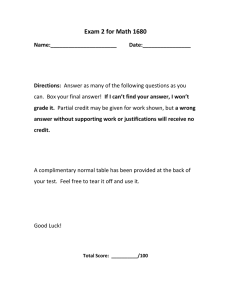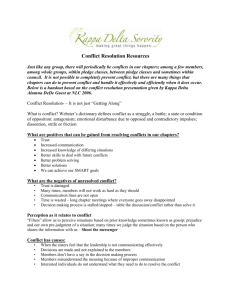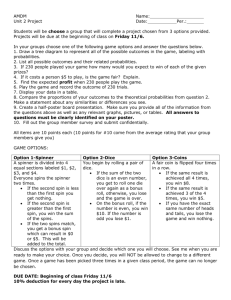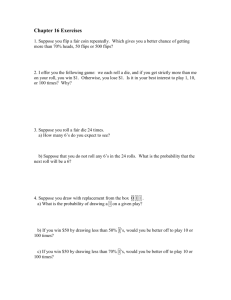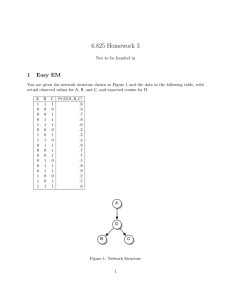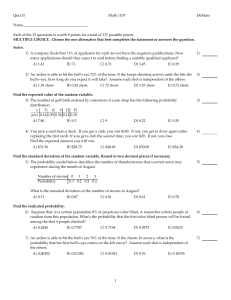Exam 1 for Math 1010
advertisement
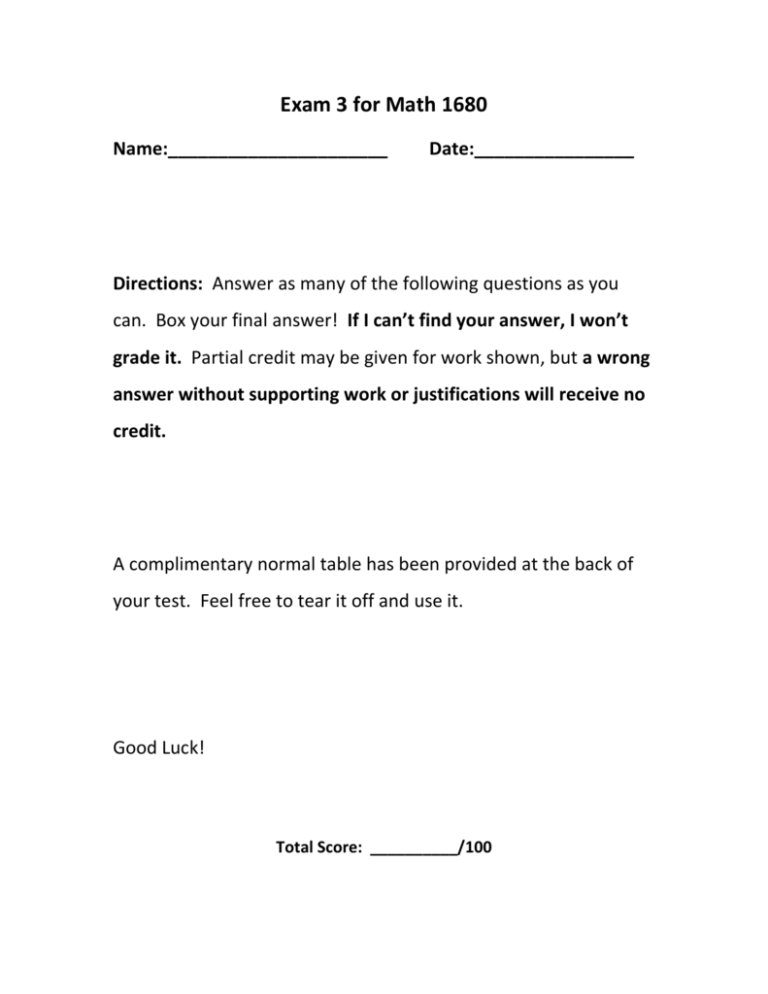
Exam 3 for Math 1680 Name:______________________ Date:________________ Directions: Answer as many of the following questions as you can. Box your final answer! If I can’t find your answer, I won’t grade it. Partial credit may be given for work shown, but a wrong answer without supporting work or justifications will receive no credit. A complimentary normal table has been provided at the back of your test. Feel free to tear it off and use it. Good Luck! Total Score: __________/100 2 Question 1 (25 points): You decide to play roulette. You bet $1 on a column, which pays 2 to 1. (In other words, you are betting that the ball will drop on one of 12 different numbers out of the 38 slots on the wheel. If it does, you win $2. Otherwise, you lose your $1 bet.) a) (6 points): Draw the box model for and calculate the expected value and standard error for a single play of this game. b) (3 points): How many plays would you have a better chance of coming out ahead with, 10 or 25 times? (Hint: what does the Law of Averages say?) c) (6 points): Suppose you play this game 25 times. What are the expected value and standard error for your gain? d) (10 points): If you played this game 25 times, approximately what is the probability that you would come out ahead? (Hint: use the normal table!) 3 Question 2 (10 points): If two parents have 4 children, what is the probability that they have at least two girls? Assume that a new child is equally likely to be a boy or a girl, and that the genders of the children are independent. Question 3 (15 points): (Hypothetical) The Texas Lottery commission offers a game where players buy a ticket for $1 and mark off 5 numbers from a field of 37. Then they compare their 5 numbers with the 5 numbers drawn with replacement from a random generator. Players win prizes of increasing value if they match any two, three, four, or all five numbers. The typical prizes for each draw are as follows. Matches 5 of 5 4 of 5 3 of 5 2 of 5 Prize $7,500 $100 $4 $2 a) (7 points): What is the probability of winning the grand prize (matching all five numbers)? b) (8 points): What is the expected value for a single play? 4 Question 4 (15 points): One ticket is drawn at random from each of the two boxes below: 1 2 3 4 5 6 1 2 3 4 5 6 a) (8 points): What is the probability that both of the numbers drawn are even? b) (7 points): What is the probability that the sum of the two numbers is 6? Question 5 (15 points): a) (8 points): If I deal 3 cards off of a well-shuffled standard deck, what is the probability that the first card is an eight, the second card is a king, and the third card is another king? b) (7 points): If I deal 3 cards off of a well-shuffled standard deck, what is the probability that all three cards are aces? 5 Question 6 (10 points): we play a game where each of us roll a red die and a green die. If your red die shows a larger number than my red die and your green die shows a number larger than my green die, then you win. Otherwise, you lose. (For example, if you roll a red 4 and a green 3 to my red 3 and green 1, then you win. If, for example, you roll a red 6 and a green 2 to my red 4 and green 2, then you lose.) What is the probability that you win this game? Question 7 (10 points): Suppose you flip a fair coin some number of times, and you win $10 if the percentage of heads is between 45% and 55%. Would you be more likely to win the $10 if you flipped 10 or 1,000 times? Why? 6 Question 8 (21 points): Suppose you draw 100 tickets from the box 0 x 110 1 x 2,390, without replacement. a) What percentage of your sample do you expect to be 1’s? How far off are you likely to be? b) What percentage of your sample do you expect to be 0’s? How far off are you likely to be? c) Can you use the normal curve to estimate the probability that you get fewer than 95% 1’s? If so, then estimate it. If not, explain why not. Question 9 (15 points): A sample of 80 tickets from a large box has 47% 1’s. a) What percentage of the entire box do you estimate to be 1’s? What is the standard error on your estimate? b) Can you give a meaningful 99.7% confidence interval for the percentage of 1’s in the box? If so, then estimate it. If not, explain why not.



